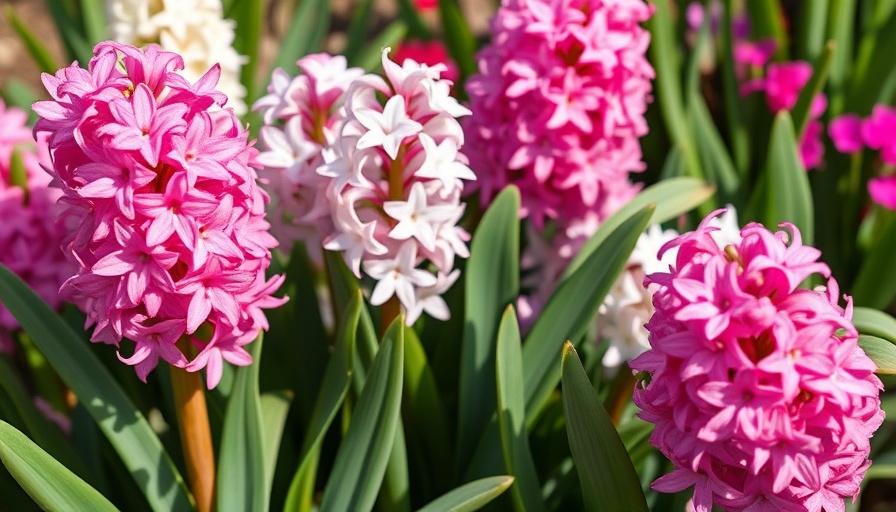
Understanding Hyacinths: The Beauty of Their Blooms
Hyacinths are not just another flower; they are a sensory delight that heralds the arrival of spring. Known for their vibrant colors and intoxicating fragrance, Hyacinthus spp. are perennial bulbs that thrive in mild climates ranging from Zones 4 to 8. With flowers that can be blue, pink, purple, and white, they create stunning displays that uplift any garden.
What's Going Wrong? The Mystery of Non-Blooming Hyacinths
Gardeners often face disappointment when their beloved hyacinths grow lush green leaves but fail to produce blooms, a phenomenon commonly referred to as 'blindness.' Understanding why this happens is crucial for successful cultivation. In this article, we dive into nine potential reasons your hyacinths may be underperforming and offer practical garden tips to prevent these issues.
1. The Age Factor in Blooming
Age matters significantly when it comes to bulb performance. Under optimal conditions, hyacinth bulbs last about five years. After this period, their blooming potential diminishes, so it is wise to plan for your bulbs’ replacement before they decline. Take note of planting dates and aim to replenish your bulbs around the three to four-year mark to maintain a vibrant spring display.
2. The Impact of Crowded Conditions
As your garden grows, so may the competition for nutrients and space. Hyacinths can naturally multiply, creating a crowded environment that detracts from their blooming capabilities. By regularly dividing hyacinth bulbs in early fall after leaf dieback, you can encourage healthier plants and ensure each bulb has enough room to thrive.
3. Is Excess Nitrogen Blocking Blooms?
Nitrogen is essential for plant growth, but too much can backfire. Surplus nitrogen can lead to an overabundance of foliage while stunting flower production. If you find yourself needing to fertilize, consider using a balanced fertilizer with a ratio that encourages blooms, such as 5-10-5. This can help redirect energy from leaf production to flower formation.
4. Soaking Up the Sun: The Light Requirement
Hyacinths prefer full to partial sunlight, and without adequate light, they may struggle to bloom. Make sure you plant them in a sunny spot in your garden to ensure they receive enough energy to thrive.
5. Indoor Forcing: A Double-Edged Sword
While it’s lovely to force hyacinths indoors for a winter bloom, this can lead to confusion when they’re moved outdoors in spring. If they are placed in a garden that doesn’t replicate their earlier growing conditions, they may choose to grow leaves rather than blooms. Following a careful acclimatization process can help mitigate this issue.
6. Pests in the Garden: The Sneaky Threats
Mice and other garden pests can pose a serious threat to your hyacinths. These critters may eat the bulbs or disturb the plant environment, leading to underperformance. Implement organic gardening practices to deter pests, ensuring your bulbs are safe and sound.
7. Moisture Stress: The Balance of Water
Hyacinths do best in well-drained soil. Both over-watering and drought can result in stress that inhibits blooming. Monitoring soil moisture levels and adapting your irrigation strategy can help keep your bulbs healthy.
8. Depth Matters: Planting Too Deep
When planting hyacinths, ensuring they are at the correct depth is vital. Bulbs set too deep may lack the energy to reach the surface and bloom. A good rule of thumb is to plant them at a depth of about four to six inches.
9. Weather Conditions: Unpredictable Elements
Spring weather can be unpredictable. Late frosts or unseasonably warm temperatures can shock your hyacinths and lead to poor blooming. Planning for protective measures like mulch can help buffer against temperature fluctuations, ensuring your blooms have the best chance to flourish.
Key Takeaways: Cultivating Blooming Success
With a little attention and care, you can cultivate a flourishing garden filled with beautiful blooming hyacinths. Remember to consider factors such as age, crowding, nutrient levels, and environmental conditions. By implementing strategic gardening tips and understanding your plants' needs, you're well on your way to enjoying the sweet sights and scents of spring. So dig in, pay attention, and let your garden blossom!
 Add Row
Add Row  Add
Add 




Write A Comment